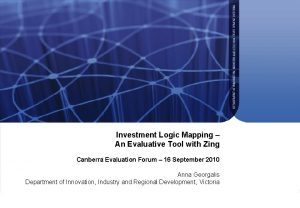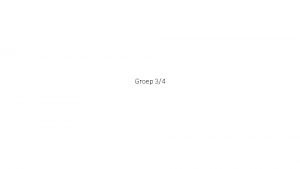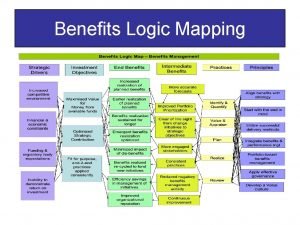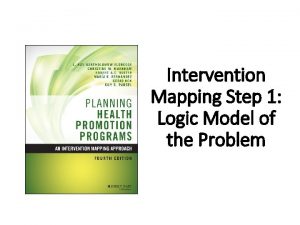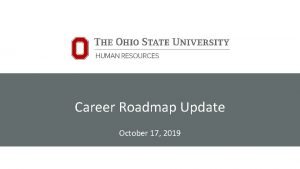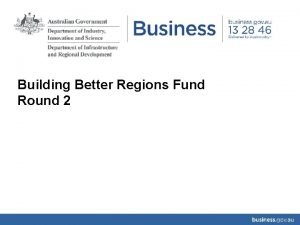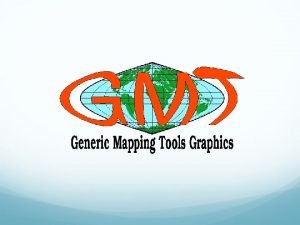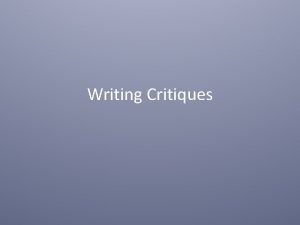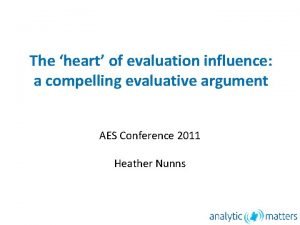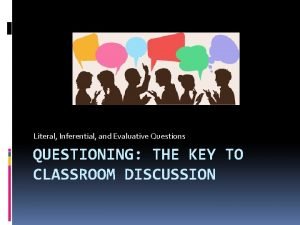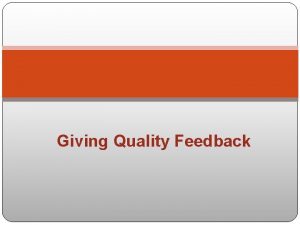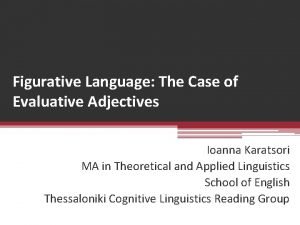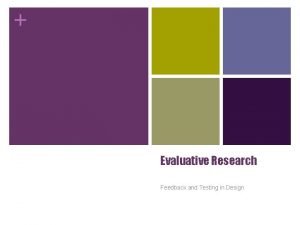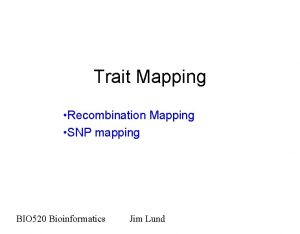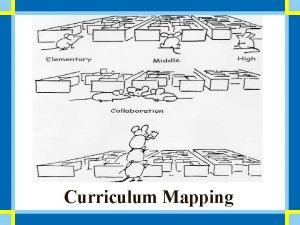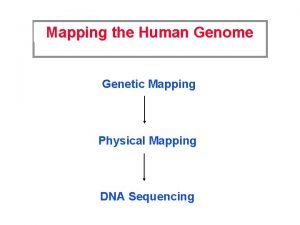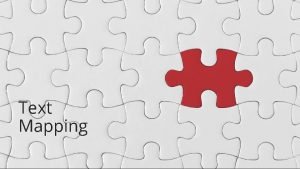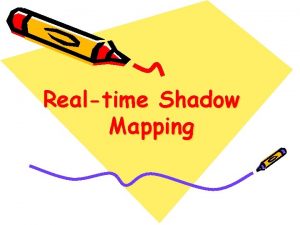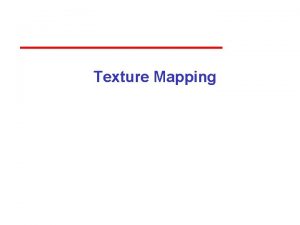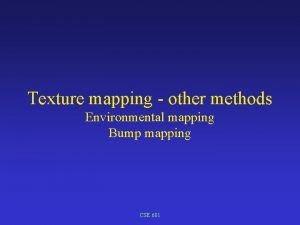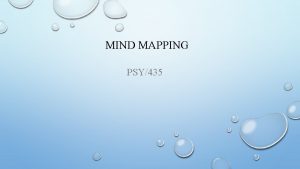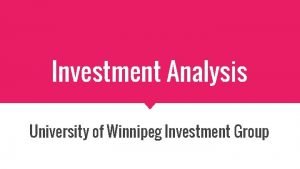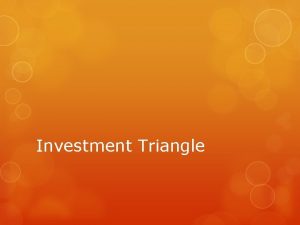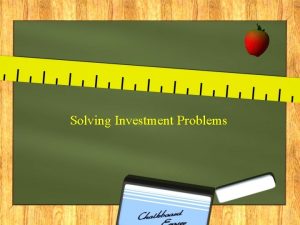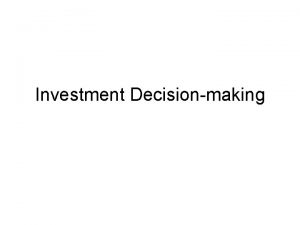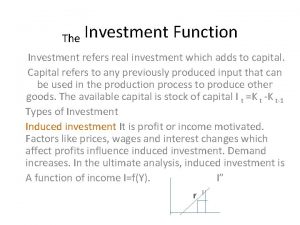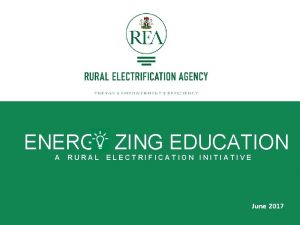Investment Logic Mapping An Evaluative Tool with Zing






























- Slides: 30

Investment Logic Mapping – An Evaluative Tool with Zing Canberra Evaluation Forum – 16 September 2010 Anna Georgalis Department of Innovation, Industry and Regional Development, Victoria

Today’s presentation About the Victorian Department of Innovation, Industry and Regional Development (DIIRD) Evaluation activity at DIIRD The Victorian Department of Treasury and Finance (DTF) Investment Management Standard and Investment Logic Maps (ILMs) An evaluation approach using ILMs Results of the approach

About DIIRD is the Victorian Government’s lead agency for economic and regional development The Department develops and implements a diverse range of programs, initiatives and projects designed to: − attract and facilitate investment; − encourage exports and industry development; − foster skills development; − stimulate innovation; and − promote Victoria nationally and internationally Benefits to the community: − increased investment, exports and high-quality jobs

Evaluation at DIIRD Approach defined by the DIIRD Evaluation Policy, signed off by the Secretary Small team of four full time equivalent staff (Evaluation Unit) Annual evaluation plan developed

Functions of the Evaluation Unit Conduct policy and program evaluations Conduct triple bottom line evaluations (economic, social and environmental) of major events funded by the Victorian Government Build evaluation capability across DIIRD Provide advice and support on evaluation strategies and projects

Continuous Improvement Cycle

Benefits of evaluation Supports continuous improvement of programs, initiatives and policies Provides evidence for business case development for funding proposals Strengthens reporting to DIIRD Executive, Central Agencies and Parliament

Scenario in the early days… Evaluation reports were not ‘hitting the mark’ with stakeholders The scope of the program being evaluated was not clear The evaluation reports were not evidence based and lacked quantitative data to support findings and recommendations Consultants undertaking evaluations were not being given clear guidance The necessary data for the evaluation were not available

The evaluation approach promoted at DIIRD Involve stakeholders throughout the process Clearly articulate the outputs and desired outcomes of a policy, program or initiative that is/will be evaluated Use Investment Logic Maps (ILMs)

The evaluation approach promoted at DIIRD (continued) Define evidence and data required for effective monitoring and evaluation: a. Develop a performance monitoring framework early in the life cycle of a program to collect the relevant data; or b. Develop an evaluation framework that guides the scope of an evaluation and determines what data will need to be collected to ensure a rigorous evaluation (is usually provided to consultants)

The evaluation approach promoted at DIIRD (continued) Frameworks will contain: − Evaluation questions that are aligned with the elements of the ILM − Performance measures designed to support evaluation questions − Data to support the performance measures − Tools that will be used to gather data − Surveys and interviews that are aligned with the performance measures The evaluation report is structured on the framework

The Investment Management Standard Developed by the Victorian Department of Treasury and Finance (DTF), the standard has been evolving since 2004 Lightweight common-sense practices that have assisted departments improve the way they develop and manage investments The centrepiece of the standard is the ILM

The Investment Management Standard

Investment Management compared with Project Management PROJECT management INVESTMENT management Will the project complete within budget? Is the logic for the planned investment clear? Will it deliver to its planned schedule? Is there a sound business case to proceed? Were the expected products delivered? Were the expected benefits achieved?

The Investment Logic Map (ILM) An approach that engages with the Investor and key stakeholders to shape the investment decisions in a series of ‘intelligent discussions’ Structured two-hour workshops (generally up to three, depends on complexity and maturity of proposal) Facilitated by people who are skilled in the approach who test the rigour and evidence behind the investment

ILM (continued) One page graphical representation of the logic of an investment proposal that contains: − The problem being addressed − The intervention (what Government wants to do) − The benefits for the community − The solution including the necessary changes and assets needed

Example of ILM

Differentiation with DTF approach DTF uses outputs for their changes We promote the use of intermediate outcomes or critical success factors that need to be achieved to deliver on the interventions

An example…

ILMs in practice Business cases Policy development Problem solving Strategic planning Evaluation and monitoring activities

ILMs and monitoring and evaluation Performance monitoring framework at the commencement of a program or An evaluation framework for evaluation activity

Benefits of using ILMs Shared understanding of an issue through informed intelligent discussion A concise and rigorous argument to solve a problem The most appropriate solution to an issue Clear and accountable description of a policy or program

The evaluation approach in detail An ILM is developed and signed off by the Program Manager Frameworks are developed by applying evaluation questions against each element of the ILM around: − Appropriate/relevance − Effectiveness − Efficiency − Lessons learned − Future directions Performance measures are then developed that will support answering the evaluation question Data sources and inputs are also determined

The approach in practice Investment Logic Map Evaluation Framework Evidence (survey)

The approach in practice (continued)

A framework is the key quality assurance step in the approach Survey and interview questions are aligned with performance measures and evaluation questions Ensure all necessary data is collected for the evaluation Frameworks guide the content of the evaluation report

Advantages of the approach Stakeholders are engaged and sign-off at key points Scope of program and evaluation clearly articulated Appropriate evidence and data is collected Clear guidance available to consultants especially through the ‘request for quote’ process

Results from the approach Evaluation reports ‘hitting the mark’ with stakeholders Greater engagement of stakeholders Better defined scope More data available and evidence based reports Consultants delivering a higher standard of reports Better and more robust recommendations to support continuous improvement

Summary Prepare an ILM or equivalent Develop a Performance Monitoring Framework or Evaluation Framework Follow it through!

Thank you Questions?
 Investment logic map
Investment logic map Robotdans
Robotdans Zing tv recharge maharashtra
Zing tv recharge maharashtra Fixed investment and inventory investment
Fixed investment and inventory investment The associative mapping is costlier than direct mapping.
The associative mapping is costlier than direct mapping. Forward mapping vs backward mapping
Forward mapping vs backward mapping Prinsip analisis dan desain
Prinsip analisis dan desain Investment logic map
Investment logic map Logic model of the problem intervention mapping
Logic model of the problem intervention mapping First order logic vs propositional logic
First order logic vs propositional logic First order logic vs propositional logic
First order logic vs propositional logic First order logic vs propositional logic
First order logic vs propositional logic Concurrent vs sequential
Concurrent vs sequential Cryptarithmetic problem logic+logic=prolog
Cryptarithmetic problem logic+logic=prolog Software development wbs
Software development wbs Majority circuit
Majority circuit Combinational logic sequential logic 차이
Combinational logic sequential logic 차이 If x = 0 and y = 1, which output line is enabled?
If x = 0 and y = 1, which output line is enabled? Career roadmap osu
Career roadmap osu Bbrf mapping tool
Bbrf mapping tool Generic mapping tools examples
Generic mapping tools examples Visualize dynamics 365 relationship chart
Visualize dynamics 365 relationship chart Ibm z890
Ibm z890 Evaluative adjectives
Evaluative adjectives Evaluative terms
Evaluative terms Evaluative argument
Evaluative argument What is a evaluative question
What is a evaluative question Understanding questions examples
Understanding questions examples Descriptive vs evaluative feedback
Descriptive vs evaluative feedback Figurative adjectives
Figurative adjectives What is evaluative listening
What is evaluative listening
